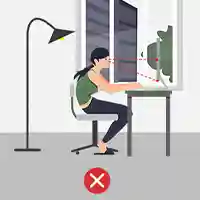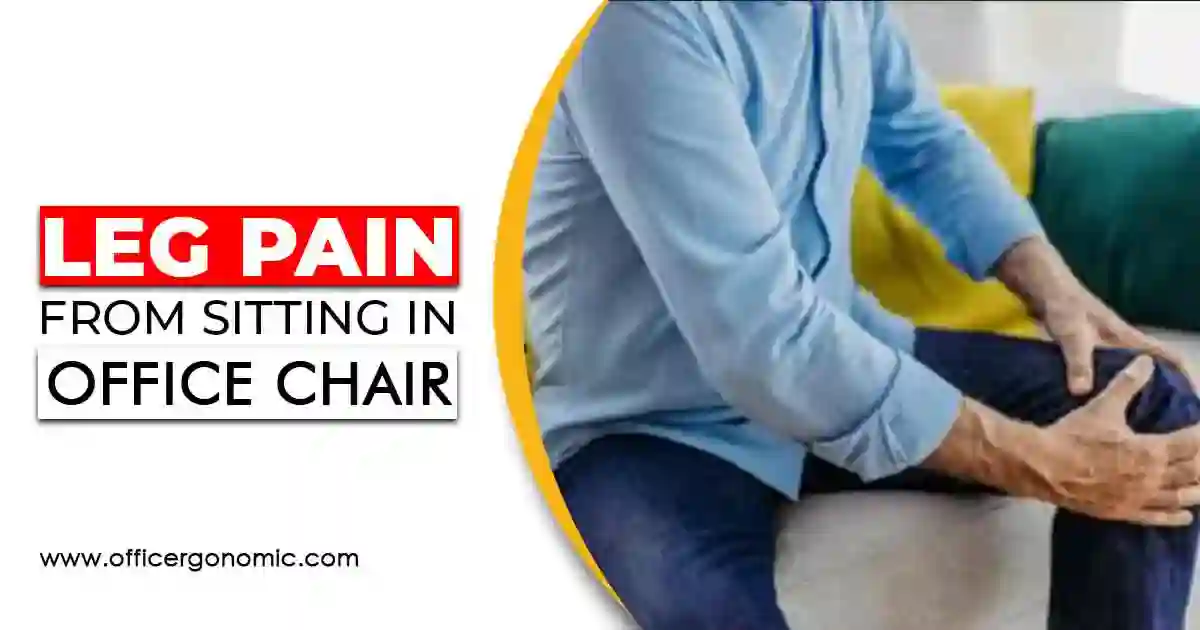Leg Pain From Sitting in Office Chair
Leg pain is a most common problem that badly hampers a person’s ability to walk and stand. Its intensity varies from mild to irritating and enervating. If the problem is ignored for a long time, it may also cause stiffness, bruising, swelling, cramping, and even seizing of muscles.
It is generally accepted that leg pain is caused due to physical activities such as running or climbing stairs. However, many people are unaware that prolonged sitting without following active sitting practices can also significantly contribute to pain in your legs. In this article, we will discuss why and how one experiences leg pain from sitting in office chair and how can you prevent it.
Leg Pain From Sitting in Office Chair Causes?
Strange but true that your sitting position is a big contributing factor to varicose veins and causing pain in your ankles and legs. Here are some causes that explain why your legs hurt when you sit for long periods during the day.

1-Poor Sitting Posture
Poor sitting posture is a major factor that causes leg and lower back pain. A good sitting posture is one in which your back is straight and your shoulders are relaxed.
Moreover, the computer screen is at eye level and your feet are flat on the floor. Any deviation from this posture puts pressure on your legs and lower body which ultimately causes pain.
2-Lack of Movement
Lack of mobility also leads to chronic pain in the legs and other body parts. Without movement, supporting muscles are weakened which builds stress on the body and joints. Moreover, it also decreases the supply of blood, oxygen, and nutrients in the body which in turn causes pain in the legs.
3-Bad or Non-Ergonomic Office Chair
A poor or non-ergonomic office chair might also contribute to pain in your legs. A hard office chair may shift the weight from your feet to your thighs which decreases blood circulation in your lower legs. This leads your muscles to start atrophy because you don’t use them enough.
Therefore, your legs have to work harder to stand up and move around after work.
4-Underlying Medical Problems
Different underlying health conditions such as arthritis, muscle cramps, ligament injury, bone fracture, or claudication can also lead to pain in the leg. Similarly, factors such as overage, pregnancy, dehydration, diabetes, nerve disorder, or alcohol use can also aggravate the problem. In some of these conditions, pain can be cured by bringing minor changes in your lifestyle while other require you to undergo a complete medical checkup.
How to Prevent Leg Pain From Sitting in the Office Chair?
There are several things that can be done to fix the leg pain caused due to sitting in an office chair. Some key tips include:
Improve Your Sitting Posture

Improving the sitting posture can help you to get rid of myriad physical problems including the pain in your legs. Avoid slouching or leaning to one side of your chair or crossing your legs.
These are the poor sitting styles that create muscular imbalances and they have to work hard to support their body weight while standing up.
The habit of slouching not only causes pain and discomfort in different body parts but also decreases the level of your productivity and attention. Therefore, improving the body posture must be your first priority when it comes to getting rid of leg pain.
Adjust the Chair According to Your Body Dimensions
A comfortable and ergonomic office chair is of no use until you adjust it according to your body type. Keep the following points in mind for adjusting the chair according to your body’s needs and preferences:
- Adjust the height of your chair so that your feet remain flat and firmly balanced on the floor and the knees are slightly lower than the level of your hips.
- Adjust the armrests in a position where your neck and shoulders remain relaxed and you get good forearm support while working.
- If your office chair does not come up with a footrest, buy a separate footrest and adjust it according to your comfort and overall functionality. The right footrest adjustment is attained when the feet are firmly balanced on the floor and you don’t feel any pressure or discomfort.
- Adjust the seat angle in a forward direction to ensure your hips are well above your knees.
- Keep your eye level with the screen so that you don’t have to put any strain on your neck or upper spine.
- Use a lumbar support cushion to maintain a good posture.
Replace the Office Chair
If you find that the office chair is the culprit behind the pain in your legs, get yourself a new office chair. Your office chair must have adjustable armrests, seat and lumbar support. It should have enough back support so that your back remains relaxed and you feel less pressure on your feet or legs.
Consult a Physician
If the above-mentioned remedies are not working out, you must consult a physician or healthcare professional to get an expert opinion. The physician will conduct a thorough examination of your body to determine the root cause of your problem.

He/she may also perform different tests such as ultrasound, blood tests, venography, X-rays or MRI to determine the root cause of your problem. Leg pain may be caused due to existing health problems such as arthritis, bone fractures, chronic exertional compartment syndrome, ligament injury, sprain, shin splints, peripheral neuropathy and many others.
Only an expert physician can help in diagnosing the root cause and recommending appropriate treatment and medication for your problem. Your doctor might also suggest you some physical exercises or manual therapies for relieving the problem.
Take Regular Brakes and Move Around
Remember to take regular breaks while sitting and moving around. It is recommended to get up after every 30 minutes and do some simple stretches. This will improve blood circulation throughout your body and promote healing. Moreover, it also improves the flexibility of muscles and joints, reducing pain and aches.
Commit to Regular Exercise
A well-designed ergonomic chair adjusted according to your body measurements would have no benefits if you don’t couple it with regular exercise. Implement a consistent workout routine to increase your muscle strength, improve blood circulation, and lowering blood pressure.

If you are overweight, it would also help in losing weight and bringing your body in shape. Walking, swimming, and cycling are low-impact exercises that are gentle on muscles and joints and still, can do wonders in improving blood circulation and reducing body pain.
However, if you want a detailed workout plan, consult a professional trainer. Most importantly, increase your water intake and avoid eating junk food as much as you can. Also, quit the habit of smoking as it can also contribute to pain in different body parts.
Final Thoughts!
In a nutshell, leg pain is a severe problem faced by many people. It is typically caused due to a sedentary lifestyle. Prolonged sitting in an office chair decreases blood circulation which causes stiffness and pain in the legs. Factors such as uncomfortable office chairs or underlying health problems can further alleviate the problem.
Fortunately, there are some measures that can be adopted to prevent leg pain. This includes bringing changes in lifestyle in general and sitting practices in particular. First of all, the chair must be adjusted to suit your body. If the chair is hard on and non-adjustable, you should also consider replacing it.
Second, you must improve your overall sitting posture and bring some physical exercise and movement into your routine. Still, if the pain persists, consult a medical practitioner so that he could give you an effective solution after critically examining your physical health.






